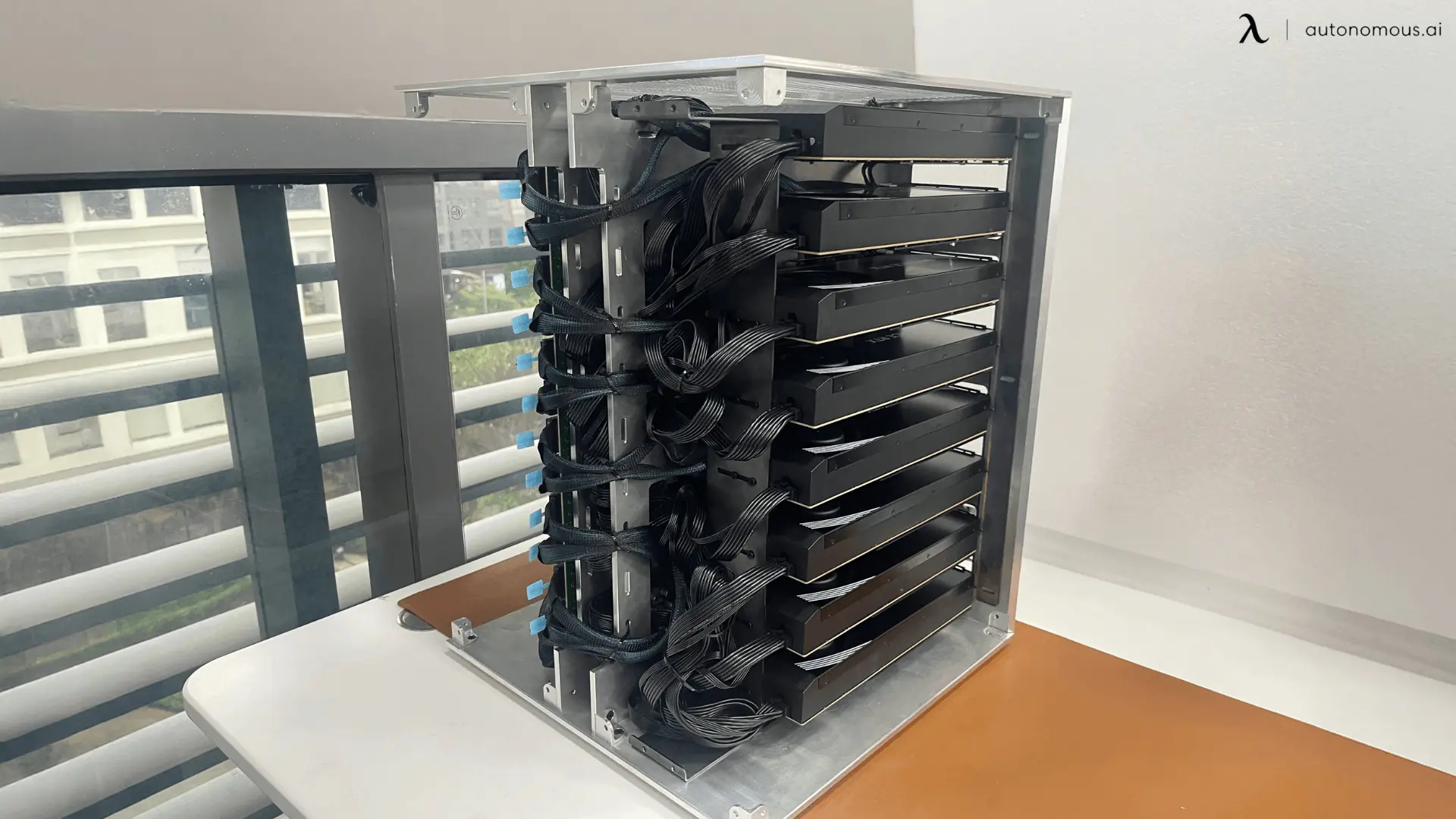.webp)
Table of Contents
In the world of artificial intelligence (AI), Edge AI is transforming how we interact with data and make real-time decisions. By processing data locally on edge devices instead of relying on cloud computing, Edge AI offers substantial benefits, including faster decision-making, enhanced privacy, and reduced costs. This technology is revolutionizing industries like healthcare, manufacturing, and retail, enabling smarter, more efficient systems.
What is Edge AI?
Edge AI refers to the deployment of AI algorithms and models directly on local devices, such as sensors, cameras, and Internet of Things (IoT) devices. Unlike traditional cloud-based AI, which relies on transmitting data to remote servers for processing, Edge AI enables real-time decision-making and data analysis right at the point of data collection.
This shift to local processing reduces latency, enhances privacy, and allows for faster responses, making Edge AI ideal for applications where immediate action is necessary, such as in autonomous vehicles, healthcare monitoring, and smart cities.
How Does Edge AI Work?
At its core, Edge AI involves four key steps:
- Data Collection: Devices like sensors and cameras gather data from their environment.
- Local Processing: AI models, often pre-trained in the cloud, are deployed to edge devices to analyze the data locally.
- Decision Making: Based on the processed data, the device makes immediate decisions or actions, such as sending alerts or adjusting settings.
- Optional Cloud Syncing: In some cases, the processed data is synced to the cloud for further analysis or to update the models.

Edge AI vs. Cloud AI: Key Differences
While both Edge AI and Cloud AI process data using AI algorithms, there are significant differences in how and where the data is processed.
- Edge AI processes data on local devices, reducing the need to send data to cloud servers. This results in lower latency, better privacy, and reduced bandwidth usage.
- Cloud AI, on the other hand, processes data on remote servers. While it offers more computational power and storage capacity, it introduces higher latency due to data transfer between devices and the cloud. For time-sensitive applications, Edge AI is often the better choice.
Edge AI provides faster, more secure, and cost-effective solutions for applications that require immediate responses. For example, in autonomous vehicles, Edge AI enables quick decision-making by processing sensor data on the vehicle itself, whereas Cloud AI would introduce delays due to the need to communicate with a remote server.
The shift from cloud to on-premises servers can significantly impact performance and cost, as explored in the benefits of transferring to on-premises servers.
Edge AI Use Cases Across Industries
Edge AI is revolutionizing industries by enabling faster decision-making, real-time insights, and enhanced security. Here are some key use cases:
- Healthcare:
Wearable devices like smartwatches with Edge AI can monitor vital signs and detect falls, alerting healthcare professionals immediately. This reduces response time and enhances patient care while keeping sensitive data local. For a deeper look at cloud-based vs. on-premise healthcare solutions, explore the differences and benefits.
- Manufacturing:
Edge AI enables predictive maintenance by analyzing sensor data to identify machine malfunctions before they lead to costly downtime. This boosts operational efficiency and reduces maintenance costs.
- Retail:
Smart shopping carts and automated checkout systems use Edge AI to streamline the customer experience. By processing data locally, these systems offer faster transactions and better customer service without relying on cloud processing.
- Automotive:
In autonomous vehicles, Edge AI processes data from cameras, radar, and LIDAR sensors, enabling real-time navigation and decision-making. This ensures the vehicle can respond immediately to road conditions and potential hazards.
- Security & Surveillance:
Edge AI enhances security systems by analyzing video footage locally, enabling faster identification of suspicious activities and triggering immediate responses.

Benefits of Edge AI
The adoption of Edge AI brings a host of benefits for businesses and end-users:
- Low Latency:
Edge AI enables real-time data processing without delays from cloud communication, making it ideal for applications like autonomous vehicles and healthcare monitoring.
- Enhanced Data Privacy:
By processing data locally on devices, Edge AI reduces the risk of sensitive information being exposed to cloud-based servers, offering better privacy protection. Learn more about private AI and its impact on data security.
- Cost Efficiency:
Edge AI eliminates the need for expensive cloud resources, saving businesses significant operational costs by processing data locally instead of in the cloud.
- Reduced Network Strain:
With Edge AI, the amount of data sent to the cloud is minimized, reducing the burden on network bandwidth and enabling faster data transmission across other applications.
How Edge AI Works with Your Devices: Real-World Applications
Edge devices, such as cameras, wearables, and sensors, are the backbone of Edge AI technology. For example, smart cameras equipped with Edge AI can process video footage in real-time, detecting potential security threats and alerting users without needing to transmit data to the cloud. Similarly, wearable health devices can monitor vital signs and make immediate decisions, such as alerting a user or a healthcare provider about abnormal readings.
To support such demanding applications, EdgeAI Computer offers GPU-powered AI that seamlessly integrates with these devices. With its NVIDIA RTX 4090D GPUs, the EdgeAI Computer enables businesses to perform real-time video analysis and predictive health monitoring. This results in optimized operations, improved user experiences, and efficient decision-making at the edge, reducing latency and reliance on cloud infrastructure.
For a deeper understanding of AI computers, visit what is an AI PC. A comparative analysis of GPU server offerings provides insights into Autonomous Brainy versus DigitalOcean GPU Droplets.
.webp)
Challenges and Considerations in Implementing Edge AI
Despite its benefits, implementing Edge AI comes with challenges, such as:
- Hardware Diversity: Devices used for Edge AI vary widely in terms of processing power, memory, and connectivity. Ensuring compatibility across devices is essential for successful deployment.
- Security Risks: While Edge AI enhances data privacy, the security of edge devices themselves must be ensured to prevent unauthorized access.
- Data Synchronization: Synchronizing data between edge devices and the cloud for model updates or analytics can present challenges in distributed environments.
The EdgeAI Computer addresses these challenges by providing a custom-built, scalable solution that integrates advanced NVIDIA GPUs with easy deployment and plug-and-play functionality, ensuring security and seamless operation.
The Future of Edge AI
The future of Edge AI is promising, with rapid advancements in AI chips, 5G connectivity, and edge computing infrastructure. As more devices become AI-powered, Edge AI will play an even more significant role in industries like smart cities, autonomous vehicles, and industrial IoT.
With solutions like the EdgeAI Computer, businesses can capitalize on the growing demand for Edge AI, enabling efficient real-time data processing, greater security, and cost savings. 5G networks will also accelerate the adoption of Edge AI, providing faster data transfer speeds and reduced latency.
FAQs
What is Edge AI?
Edge AI refers to the deployment of artificial intelligence models directly on local devices, enabling real-time data processing and analysis without relying on cloud infrastructure. This allows for faster decision-making and improved privacy by processing data locally.
How does Edge AI work?
Edge AI works by enabling devices at the edge (e.g., IoT devices, sensors, or cameras) to collect, process, and act on data locally. AI models are deployed on these devices, and they perform machine learning tasks in real time, allowing immediate action without the need to send data to the cloud for processing.
What industries benefit from Edge AI?
Edge AI benefits industries like healthcare, automotive, manufacturing, security, and retail, among others. In healthcare, it enables real-time patient monitoring. In autonomous vehicles, it ensures quick decision-making for safety. Edge AI helps optimize operations in smart cities and industrial automation too.
What are the benefits of using Edge AI?
The main benefits of Edge AI include reduced latency, enhanced privacy, cost efficiency, and improved operational efficiency. By processing data locally, it eliminates delays caused by cloud reliance, enhances security by not transmitting sensitive data to the cloud, and saves on bandwidth and operational costs.
How can EdgeAI Computer help businesses with Edge AI?
EdgeAI Computer offers businesses the power of local AI processing with its NVIDIA RTX 4090D GPUs, enabling real-time data analysis, faster decision-making, and better security. It provides a cost-effective and scalable solution for industries needing high-performance, on-premises AI capabilities.
Is Edge AI better than cloud AI?
Edge AI is better for applications requiring real-time processing and low latency, such as autonomous vehicles or real-time monitoring systems. While Cloud AI provides more computational power, Edge AI eliminates the risk of connectivity issues and offers better privacy by processing data locally.
What are the challenges of implementing Edge AI?
Key challenges of Edge AI include hardware compatibility, data synchronization between devices, and ensuring security at the edge. Additionally, implementing Edge AI may require integrating legacy systems and adapting existing infrastructure to handle AI processing effectively.
How much does it cost to implement Edge AI?
The cost of implementing Edge AI varies depending on the hardware and scale of deployment. While Edge AI can save on cloud costs in the long run, the initial setup may require investment in AI-capable devices, specialized processors, and infrastructure, such as the EdgeAI Computer for high-performance, on-premises AI processing.
What devices use Edge AI technology?
Devices like smartphones, wearables (e.g., smartwatches), autonomous vehicles, security cameras, and industrial machines utilize Edge AI for tasks like facial recognition, real-time health monitoring, and predictive maintenance. These devices often rely on built-in processors like GPUs or NPUs for local AI processing.
Does Edge AI require a continuous internet connection?
No, Edge AI can function without continuous internet access since it processes data locally. This makes it ideal for applications in remote locations or environments with unstable internet connectivity, such as autonomous vehicles or remote industrial sites.
Can Edge AI be used in combination with cloud AI?
Yes, Edge AI can work in conjunction with cloud AI in a hybrid model. While Edge AI handles real-time decision-making, cloud AI can manage more complex, resource-intensive tasks like model training. This combination allows businesses to optimize both local processing and cloud-based scalability.

Conclusion
Edge AI is transforming how businesses and industries operate by enabling real-time, local data processing and decision-making. With benefits like reduced latency, enhanced security, and cost efficiency, Edge AI is becoming a cornerstone of modern technology. The EdgeAI Computer offers a powerful, scalable solution for businesses looking to harness the full potential of Edge AI, providing high-performance, on-premises AI processing with unmatched privacy and security.
Spread the word
.svg)



(1).webp)



